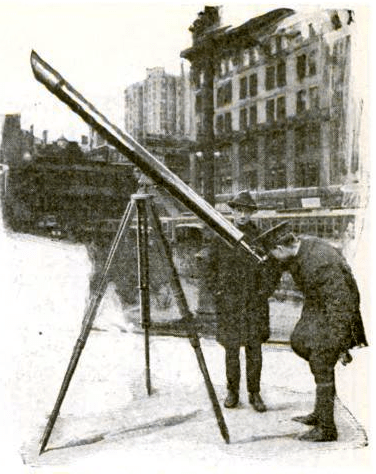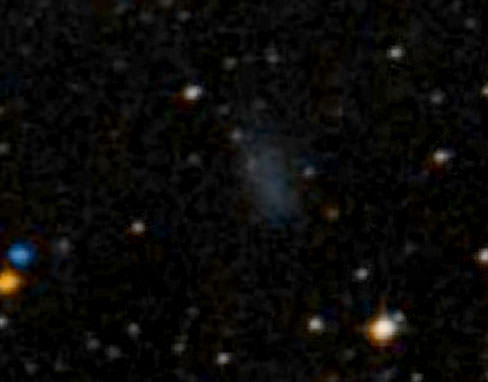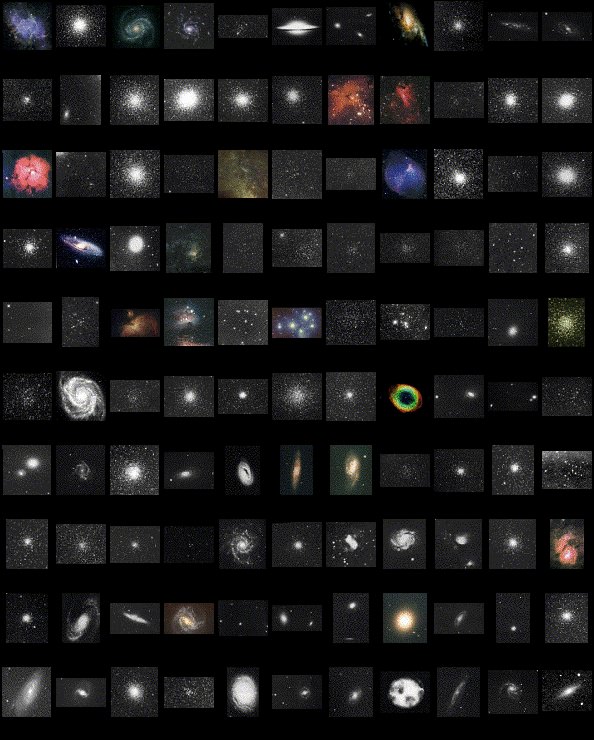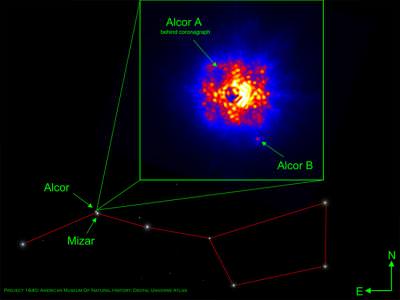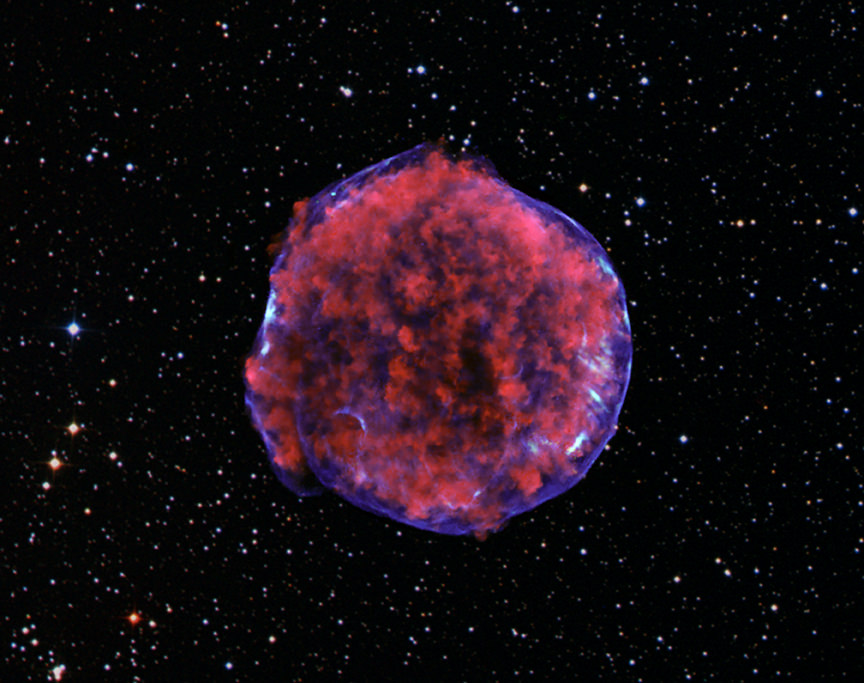I see the folks attending the third .astronomy (dotastronomy) conference this year have been busy — hacking away and creating all sorts of ingenious tools, websites and … songs. Here’s astronomer Amanda Bauer and her band of renown with their new song, “Pluto the Previous Planet.”
Continue reading “New Hit Single: “Pluto the Previous Planet””
Clyde Tombaugh’s Ten Special Commandments for Planet Hunters
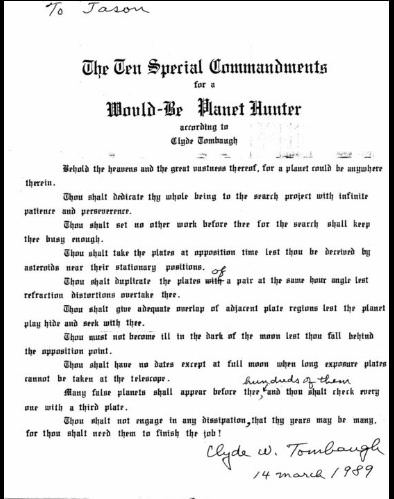
[/caption]
Back in 1989, amateur astronomer Toney Burkhart found out that Clyde Tombaugh was going to be giving a talk in San Francisco, just a short distance from Burkhart’s home. Trouble was, he found out only about 10 minutes before the presentation was going to start, so he rushed over and arrived just in time to hear Tombaugh’s talk, where he told amusing stories of how he found Pluto, and what he went through with night after night in a cold observatory taking photographs and comparing the glass plates, looking for a planet in the outer solar system. Then Tombaugh shared read his version of the Ten Commandments, called, “Ten Special Commandments for a Would-Be Planet Hunter.”
Afterward, the posters of the Commandments were being sold as a fund raising event.
“Clyde was going around the country to raise money for scholarships for young people to study planetary science,” Burkhart told Universe Today. “There were a lot of people there in the lobby buying posters autographed by Clyde Tombaugh and I wanted one very much.”
However, when Burkhart went to purchase one, he discovered that in his haste to leave his home, he had forgotten his billfold.
“I waited until everything was over and thought that I would at least go over and say hi to Clyde and tell him how much I thought of his hard work and to shake his hand, at least,” Burkhart said, and Tombaugh was more than happy to chat with an fellow astronomy enthusiast.
“While I was chatting with Clyde, I told him that I wish I brought money to buy one of the posters. He looked at me and smiled and said, ‘Well, that’s alright.’” And I said no, I really would have bought one if I had not ran out of the house and forgot my billfold. He was holding his notes and I asked him, what are you going to do with those notes, throw them away?”
Burkhart said Tombaugh smiled and replied that he couldn’t give away his notes, as he had more talks to give, but said he could mail them to Burkhart after his tour was over.
Burkhart offered to send Tombaugh a check later, or at least pay for postage, but Tombaugh looked at him and said, “No, that’s OK, I see you are really into astronomy and it would be my pleasure to give it you.”
Grateful, Burkhart asked if Tombaugh could autograph it, not for Burkhart but for his son Jason. Tombaugh took Burkhart’s address, and true to his word, about a month later Burkhart received Tombaugh’s personal version of the Commandments, with corrections made in pen, (the corrections were made by Tombaugh’s wife, Patricia, Burkhart said) along with his autograph. “I have them in safekeeping to leave to my son to have and hopefully give them to his kids,” Burkhart said.
Here are the the Ten Special Commandments for a Would-Be Planet Hunter, according to Clyde Tombaugh
1. Behold the heavens and the great vastness thereof, for a planet could be anywhere therein.
2. Thou shalt dedicate thy whole being to the search project with infinite patience and perseverance.
3. Though shalt set no other work before thee for the search shall keep thee busy enough.
4. Though shalt take the plates at opposition time lest thou be deceived by asteroids near their stationary positions.
5. Though shalt duplicate the plate of a pair at the same hour angle lest refraction distortions overtake thee.
6. Thou shalt give adequate overlap of adjacent plate regions lest the planet play hide and seek with thee.
7. Thou must not become ill in the dark of the moon lest thou fall behind the opposition point.
8. Thou shalt have no dates except at full moon when long exposure plates cannot be taken at the telescope.
9. Many false planets shall appear before thee, hundreds of them, and thou shalt check every one with a third plate.
10. Thou shalt not engage in any dissipation, that thy years may be many for thou shalt need them to finish the job!
Clyde W. Tombaugh
14 March 1989
Burkhart shared the scan of Tombaugh’s notes on his Facebook page.
h/t to Charles Bell.
Now is the Time for Observing Saturn in the Night Sky
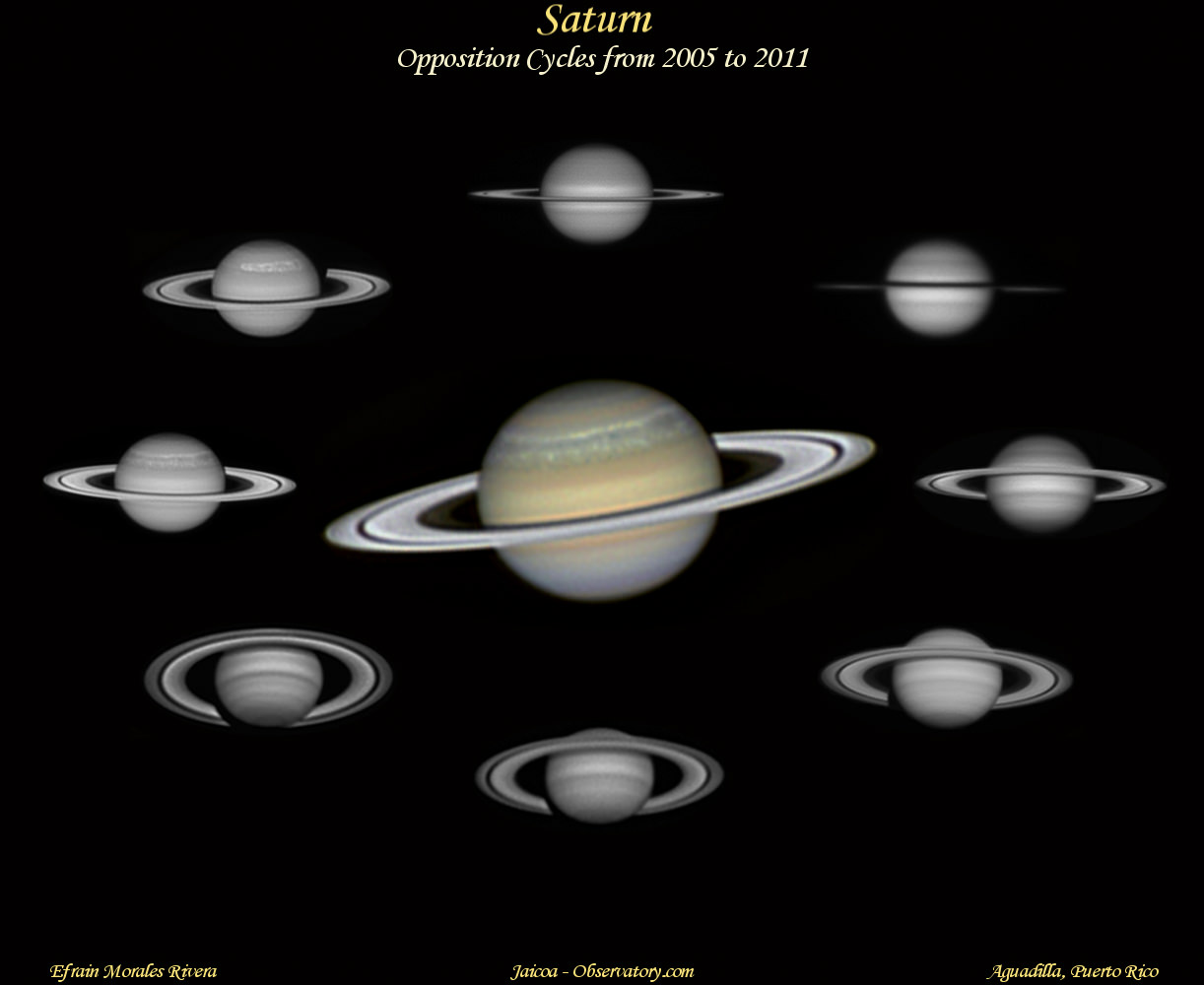
[/caption]
April is Global Astronomy Month, and as a highlight, the “Lord of the Rings” is back prominently in the night sky! This past weekend, Saturn reached opposition, when it is closest to the Earth in its orbit. Opposition means Saturn is directly opposite the Sun in the sky, so it rises in the east at sunset and sets in the west at sunrise – meaning it will be in the sky all night long! Saturn is also the only planet visible before midnight in April. But the beautiful ringed planet will be looking even brighter that it has been for the past few months.
Special thanks to Efrain Morales Rivera for sending us this montage of Saturn images, showing a current view of Saturn in the middle and the ringed planet at oppositions from the last six years.
Around opposition there is a phenomenon known as the Seeliger Effect, which might actually be a couple of different effects combining to enhance the brightness of Saturn: Since the Earth is smack dab in the middle of the Sun and Saturn, sunlight is coming from directly behind us and directly at Saturn. And there’s also the phenomenon called coherent backscattering, which is where if you shine a beam of light at something that is made from a lot of separate particles (like Saturn’s rings) the light is reflected back with greater intensity from the direction directly opposite the beam. The middle image of Saturn in the montage above reveals brighter rings from the Seeliger Effect, as well as highlighting the ‘Serpent storm’ in the northern hemisphere.
You can read more about the Seeliger Effect on AstroBob’s website.
This is also a great time to try and see some of Saturn’s moons, too.
Astronomers Without Borders are sponsoring a special Saturn Watch event April 11-16. See their website for more information about “Saturn Watch” and activity suggestions.
Here are more Saturn resources.
There are also several other fun observing events for Global Astronomy Month:
On April 9 the Global Star Party will unfold as darkness sweeps around the Earth. This is the night to set up your telescopes and share the wonders of the sky with others.
From April 10 to 16 it’s Lunar Week, to turn your gaze turns toward Earth’s natural satellite, and take a close-up look the Moon’s craters and “seas”.
April 12th is Yuri’s Night — and a very special one too, as it is the 50th anniversary of the first human in space.
April 17 is SunDay, highlighting our very own star.
The month closes with the Lyrid Meteor shower. On April 21/22 get comfortable in something warm and spend
the night scanning the sky for meteors caused by debris left behind by Comet Thatcher.
See more on the Global Astronomy Month website.
You can hear a podcast about Dark Skies Month on the April 5th 365 Days of Astronomy podcast.
Kickstarting the Joy of Astronomy
[/caption]
You’re probably familiar with Sidewalk Astronomy – where amateur astronomers set up telescopes on street corners or other public places to share free views through a telescope with those who might not otherwise have the chance. These are great opportunities for public education about astronomy and the Universe in which we live. We just got a note from a long-time sidewalk astronomer, Jay Horowitz, who has a plan to set up telescopes on A LOT of street corners. He wants to share telescope views of the skies with people all over the US. But he needs a little help to make his plan come to fruition.
“ I want to give thousands of people the opportunity to see firsthand the universe in which we live, turning young minds on to the power of science and sparking curiosity and awe in adults,” Jay wrote us in an email. And so, he has set up a Kickstarter page – and you might be familiar with this new “crowd sourcing” way to fund creative projects.
Kickstarter projects are efforts by people to do something they love, something fun, or at least something of worthwhile and of note. But they might not have the funds to do it. Kickstarter is an all-or-nothing funding method where projects must be fully-funded or no money changes hands.
Check out Jay’s Astronomy On The Road Kickstarter project, where his goal is to take science around the country in 2011 and 2012. He’s looking to raise money for a Schmidt-Cassegrain telescope, a solar telescope, and fuel for transporting the telescopes between locations. He and his group will provide free views of the skies in schools, libraries, and on city streets all over the United States.
“The telescopes will always be used for public education and will never be for private use, even down the road,” Jay said.
There are also some notable prizes for those who donate, including lunch with some of the big names in astronomy.
Jay’s Sidewalk Astronomy resume is impressive: he founded a successful sidewalk astronomy group in New York City and also volunteered as a telescope operator and educator at an observatory, and taught astronomy in the Dominican Republic.
Consider donating to this great project. You can also follow the project on Twitter.
Finding the Failed Supernovae
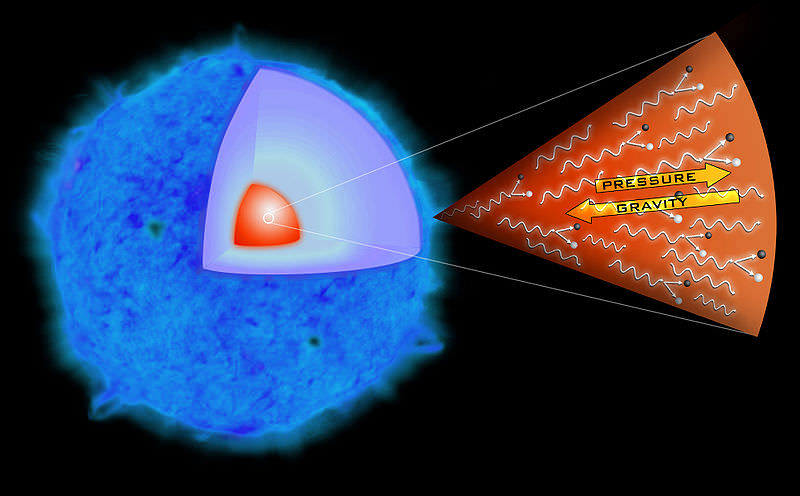
[/caption]
When high mass stars end their lives, they explode in monumental supernovae. But, when the most massive of these monsters die, theory has predicted that they may not even reveal as much as a whimper as their massive cores implode. Instead, the implosion occurs so quickly, that the rebound and all photons created during it, are immediately swallowed into the newly formed black hole. Estimates have suggested that as much as 20% of stars that are massive enough to form supernovae collapse directly into a black hole without an explosion. These “failed supernovae” would simply disappear from the sky leaving such predictions seemingly impossible to verify. But a new paper explores the potential for neutrinos, subatomic particles that rarely interact with normal matter, could escape during the collapse, and be detected, heralding the death of a giant.
Presently, only one supernova has been detected by its neutrinos. This was supernova 1987a, a relatively close supernova which occurred in the Large Magellanic Cloud, a satellite galaxy to our own. When this star exploded, the neutrinos escaped the surface of the star and reached detectors on Earth three hours before the shockwave reached the surface, producing a visible brightening. Yet despite the enormity of the eruption, only 24 neutrinos (or more precisely, electron anti-neutrinos), were detected between three detectors.
The further away an event is, the more its neutrinos will be spread out, which in turn, decreases the flux at the detector. With current detectors, the expectation is that they are large enough to detect supernovae events around a rate of 1-3 per century all originating from within the Milky Way and our satellites. But as with most astronomy, the detection radius can be increased with larger detectors. The current generation uses detectors with masses on the order of kilotons of detecting fluid, but proposed detectors would increase this to megatons, pushing the sphere of detectability to as much as 6.5 million light years, which would include our nearest large neighbor, the Andromeda galaxy. With such enhanced capabilities, detectors would be expected to find neutrino bursts on the order of once per decade.
Assuming the calculations are correct and that 20% of supernova implode directly, this means that such gargantuan detectors could detect 1-2 failed supernovae per century. Fortunately, this is slightly enhanced due to the extra mass of the star, which would make the total energy of the event higher, and while this wouldn’t escape as light, would correspond to an increased neutrino output. Thus, the detection sphere could be pushed out to potentially 13 million lightyears, which would incorporate several galaxies with high rates of star formation and consequently, supernoave.
While this puts the potential for detections of failed supernovae on the radar, a bigger problem remains. Say neutrino detectors record a sudden burst of neutrinos. With typical supernovae, this detection would be quickly followed with the optical detection of a supernova, but with a failed supernova, the followup would be absent. The neutrino burst is the beginning and end of the story, which could not initially positively define such an event as different from other supernovae, such as those that form neutron stars.
To tease out the subtle differences, the team modeled the supernovae to examine the energies and durations involved. When comparing failed supernovae to ones forming neutron stars, they predicted that the failed supernovae neutrino bursts would have shorter durations (~1 second) than ones forming neutron stars (~10 seconds). Additionally, the energy imparted in the collision that makes up the detection would be higher for failed supernovae (up to 56 MeV vs 33 MeV). This difference could potentially discriminate between the two types.
Profile of a Lonely Galaxy
[/caption]
The vast majority of galaxies exist in clusters. These clusters are joined on larger scales by filaments and sheets of galaxies, between which, gigantic galactic voids are nearly entirely free of galaxies. These voids are often hundreds of million of light years across. Only rarely does a lonely galaxy break the emptiness. Our own Milky Way rests in one of these large sheets which borders the Local Void which is nearly 200 million light years across. In that emptiness, there have been tentative identifications of up to sixteen galaxies, but only one has been confirmed to actually be at a distance that places it within the void.
This dwarf galaxy is ESO 461-36 and has been the target of recent study. As expected of galaxies within the void, ESO 461-36 is exceptionally isolated with no galaxies discovered within 10 million light years.
What is surprising for such a lonely galaxy is that when astronomers compared the stellar disc of the galaxy with a mapping of hydrogen gas, the gas disc was tilted by as much as 55°. The team proposes that this may be due to a bar within the galaxy acting as a funnel along which gas could accrete onto the main disc. Another option is that this galaxy was recently involved in a small scale merger. The tidal pull of even a small satellite could potentially draw the gas into a different orbit.
This disc of gas is also unusually extended, being several times as large as the visual portion of the galaxy. While intergalactic space is an excellent vacuum, compared to the space within voids it is a relatively dense environment. This extreme under-density may contribute to the puffing up of the gaseous disc, but with the rarity of void galaxies, there is precious little to which astronomers can compare.
Compared with other dwarf galaxies, ESO 461-36 is also exceptionally dim. To measure brightness, astronomers generally use a measure known as the mass to light ratio in which the mass of the galaxy, in solar masses, is divided by the total luminosity, again using the Sun as a baseline. Typical galaxies have mass to light ratios between 2 and 10. Common dwarf galaxies can have ratios into the 30’s. But ESO 461-36 has a ratio of 89, making it among the dimmest galaxies known.
Eventually, astronomers seek to discover more void galaxies. Not only do such galaxies serve as interesting test beds for the understanding of galactic evolution in secular environments, but they also serve as tests for cosmological models. In particular the ΛCDM model predicts that there should be far more galaxies scattered in the voids than are observed. Future observations could help to resolve such discrepancies.
Fancy doing a Messier Marathon this Weekend?
[/caption]
If you are new to astronomy, you may ask “what is a Messier Marathon and how do I do one?”
Basically a Messier Marathon is an all night (Dusk til Dawn) observing session held around mid March/ early April every year, where an observer attempts to see all, or as many of the 110 Messier objects as listed by Charles Messier.
The Messier list includes: Nebulae, Galaxies, Star clusters, Supernovae and many other deep sky objects. All of the objects in the Messier list are observable with small amateur telescopes and many of the objects are observable with binoculars.
The reason why Messier marathons take place from mid March to early April is because this is when all of the objects are visible in one evening. Other times of the year aren’t suitable as some of the objects will be in daylight or below the horizon etc.
You don’t have to be an astronomy ace or a seasoned astronomer to do a Messier marathon, but you will need a good telescope to see all of the objects. You don’t even need to do a full Messier marathon as many people do half marathons and depending on your location, or when you observe, you may not be able to see all 110 objects as there is a very tight window of opportunity and higher latitude observers do lose a couple of objects below the horizon.
Timing is key to enable you to see as many of 110 messier objects as possible. Many astronomers put tables and even star charts on the internet to help observers see as many objects as possible.
Observing starts at dusk and ends after dawn and on average each object gets about 5 minutes of observing time before you have to move onto the next one. There can be a short respite half way through the observing session for food and rest, but this depends on the order and success of the objects you are viewing?
Before starting your night of viewing Charles Messier’s wonders, make sure you have all your equipment ready, are dressed warm as it will get cold, have all your charts and viewing tables ready. It also helps to have a hot drink and something nice to eat.
The best dates this year for doing a Messier Marathon have passed and the sky was drenched with the glow of the full moon, but we still have early April. Good luck.
Charles Messier (26 June 1730 – 12 April 1817) was a French astronomer most notable for publishing an astronomical catalogue consisting of deep sky objects such as nebulae and star clusters that came to be known as the 110 “Messier objects”. The purpose of the catalogue was to help astronomical observers, in particular comet hunters such as himself, distinguish between permanent and transient objects in the sky.
Stardust-NExT sees Jets and impact crater at Comet Tempel 1 and says Farewell !
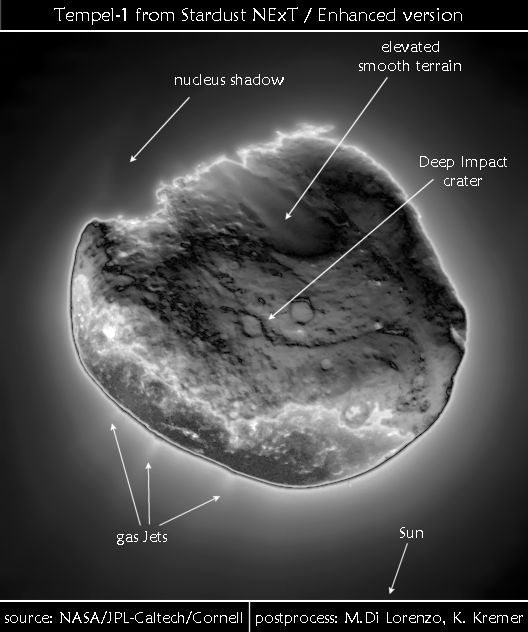
[/caption]Farewell Stardust-NExT !
Today marks the end to the final chapter in the illustrious saga of NASA’s Stardust-NExT spacecraft, a groundbreaking mission of cometary exploration.
Mission controllers at NASA’s Jet Propulsion Laboratory commanded the probe to fire the main engines for the very last time today at about 7 p.m. EDT (March 24). The burn will continue until the spacecraft entirely depletes the tiny amount of residual fuel remaining in the propellant tanks. The Stardust probe is now being decommissioned and is about 312 million kilometers away from Earth.
This action will effectively end the life of the storied comet hunter, which has flown past an asteroid (Annefrank), two comets (Wild 2 and Tempel 1) and also returned the first ever pristine samples of a comet to Earth for high powered analysis by the most advanced science instruments available to researchers.
NASA’s Stardust space probe completed her amazing science journey on Feb. 14, 2011 by streaking past Comet Tempel 1 at 10.9 km/sec, or 24,000 MPH and successfully sending back 72 high resolution images of the comets nucleus and other valuable science data. Tempel 1 became the first comet to be visited twice by spacecraft from Earth.
During the Feb. 14, 2011 flyby of Comet Tempel 1, Stardust-NExT discovered the man-made crater created back in 2005 by NASA’s Deep Impact mission and also imaged gas jets eminating from the comet. My imaging partner Marco Di Lorenzo and myself prepared two posters illustrating the finding of the jets and the Deep Impact crater included in this article.
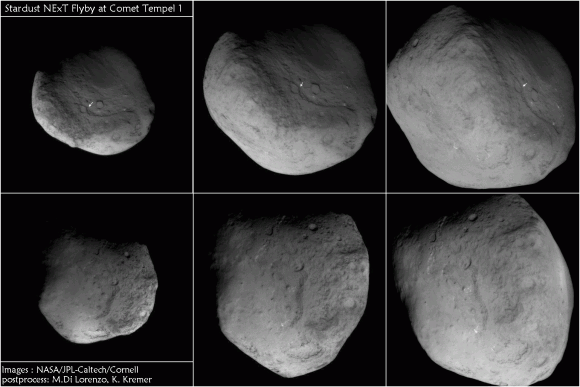
The images progress in time during closest approach to comet beginning at upper left and moving clockwise to lower left. Credit: NASA/JPL-Caltech/University of Maryland/Post process and annotations by Marco Di Lorenzo/Kenneth Kremer
The rocket burn will be the last of some 2 million rocket firings all told since the Stardust spacecraft was launched back in 1999. Over a dozen years, Stardust has executed 40 major flight path maneuvers and traveled nearly 6 billion kilometers.
The rocket firing also serves another purpose as a quite valuable final contribution to science. Since there is no fuel gauge on board or precise method for exactly determining the quantity of remaining fuel, the firing will tell the engineers how much fuel actually remains on board.
To date the team has relied on several analytical methods to estimate the residual fuel. Comparing the results of the actual firing experiment to the calculations derived from estimates will aid future missions in determining a more accurate estimation of fuel consumption and reserves.
“We call it a ‘burn to depletion,’ and that is pretty much what we’re doing – firing our rockets until there is nothing left in the tank,” said Stardust-NExT project manager Tim Larson of NASA’s Jet Propulsion Laboratory in Pasadena, Calif in a statement. “It’s a unique way for an interplanetary spacecraft to go out. Essentially, Stardust will be providing us useful information to the very end.”
Just prior to the burn, Stardust will turn its medium gain antenna towards Earth and transmit the final telemetry in real time. Stardust is being commanded to fire the thrusters for 45 minutes but the team expects that there is only enough fuel to actually fire for up to perhaps around ten minutes.
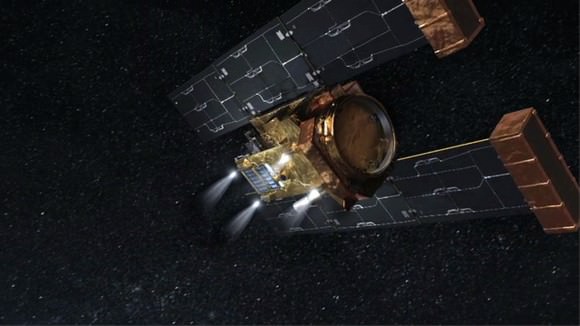
As its final act, the transmitters will be turned off (to prevent accidental transmissions to other spacecraft), all communications will cease and that will be the end of Stardust’s life.
With no more fuel available, the probe cannot maintain attitude control, power its solar array or point its antenna. And its far enough away from any targets that there are no issues related to planetary protection requirements.
“I think this is a fitting end for Stardust. It’s going down swinging,” Larson stated in the press release.
Read more about the Stardust-NExT Flyby and mission in my earlier stories here, here, here, here, here, here and here
Relive the Feb. 14 Flyby of Comet Tempel 1 in this movie of NASA/JPL images
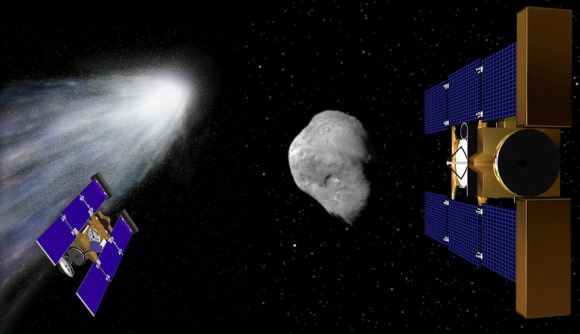
Stardust-NExT made history on Valentine’s Day - February, 14, 2011 – Tempel 1 is the first comet to be visited twice by spacrecraft from Earth. Stardust has now successfully visited 2 comets and gathered science data: Comet Wild 2 in 2004 (left) and Comet Tempel 1 in 2011 (right).
Artist renderings Credit: NASA. Collage: Ken Kremer.
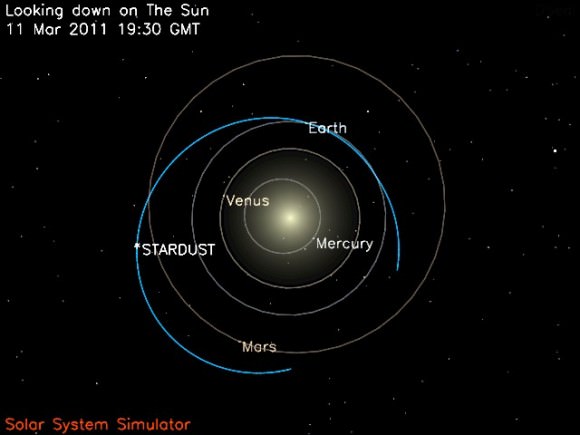
Companion Stars Could Cause Unexpected X-Rays
Many types of main sequence stars emit in the X-ray portion of the spectra. In massive stars, strong stellar winds ripping through the extended atmosphere of the star create X-ray photons. On lower mass stars, magnetic fields twisting through the photosphere heat it sufficiently to produce X-rays. But between these two mechanisms, in the late B to mid A classes of stars, neither of these mechanisms should be sufficient to produce X-rays. Yet when X-ray telescopes examined these stars, many were found to produce X-rays just the same.
The first exploration into the X-ray emission of this class of stars was the Einstein Observatory, launched in 1978 and deorbited in 1982. While the telescoped confirmed that these B and A stars had significantly less X-ray emission overall, seven of the 35 A type stars still had some emission. Four of these were confirmed as being in binary systems in which the secondary stars could be the source of the emission, leaving three of seven with unaccounted for X-rays.
The German ROSAT satellite found similar results, detecting 232 X-ray stars in this range. Studies explored connections with irregularities in the spectra of these stars and rotational velocities, but found no correlation with either. The suspicion was that these stars simply hid undetected, lower mass companions.
In recent years, some studies have begun exploring this, using telescopes equipped with adaptive optics to search for companions. In some cases, as with Alcor (member of the popular visual binary in the handle of the big dipper), companion stars have been detected, absolving the primary from the expectation of being the cause. However, in other cases, the X-rays still appear to be coming from the primary star when the resolution is sufficient to spatially resolve the system. The conclusion is that either the main star truly is the source, or there are even more elusive, sub-arcsecond binaries skewing the data.
Another new study has taken up the challenge of searching for hidden companions. The new study examined 63 known X-ray stars in the range not predicted to have X-ray emission to search for companions. As a control, they also searched 85 stars without the anomalous emission. This gave a total sample size of 148 target stars. When the images were taken and processed, it uncovered 68 candidate companions to 59 of the total objects. The number of companions was greater than the number of parent stars since some look to exist in trinary star systems or greater.
Comparing the percent of companions around X-ray stars to those that didn’t, 43% of the X-ray stars appeared to have companions, while only 12% of normal stars were discovered to have them. Some of the candidates may be the result of chance alignments and not actual binary systems giving an error of about ±5%.
While this study leaves some cases unresolved, the increased likelihood of X-ray stars to have companions suggests that the majority of cases are caused by companions. Further studies by X-ray telescopes like Chandra could provide the angular resolution necessary to ensure that the emissions are indeed coming from the partner objects as well as search for companions to even greater resolution.
New Look Inside Tycho Supernova Remnant Hints at Cosmic Ray Origins
[/caption]
The Chandra X-Ray Observatory has taken a brand new, deep look inside the Tycho Supernova Remnant and found a pattern of X-ray “stripes.” The three-dimensional-like nature of this incredible image notwithstanding, nothing like these stripe-like features has ever been seen before inside the leftovers of an exploding star, but astronomers believe they could explain how some cosmic rays are created. Additionally, the stripes provide support for a theory about how magnetic fields can be dramatically amplified in supernova blast waves.
Cosmic rays are made up of electrons, positrons and atomic nuclei and they constantly bombard the Earth. In their near light-speed journey across the galaxy, the particles are deflected by magnetic fields, which scramble their paths and mask their origins. Supernova remnants have long been thought to be the source of cosmic rays, up to the “knee” of the cosmic ray spectrum at 10^15 eV, but so far, no specific sources have been located.
In 2010, the Fermi gamma ray telescope found evidence – also from supernova remnants – where radiation is emitted that is a billion times more energetic than visible light.
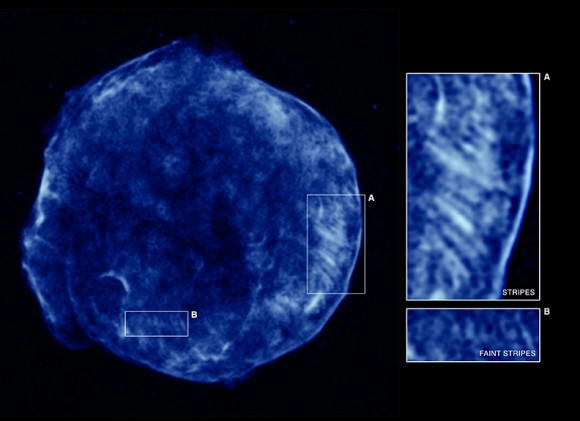
But the stripes seen by Chandra, shown above in high-energy X-rays (blue), are thought to be regions where the turbulence is greater and the magnetic fields more tangled than surrounding areas. Electrons become trapped in these regions and emit X-rays as they spiral around the magnetic field lines. Regions with enhanced turbulence and magnetic fields were expected in supernova remnants, but the motion of the most energetic particles — mostly protons — was predicted to leave a messy network of holes and dense walls corresponding to weak and strong regions of magnetic fields, respectively.
Therefore, the detection of stripes was a surprise.
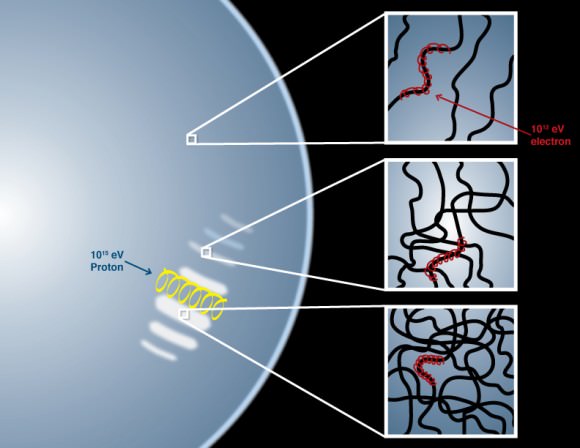
The size of the holes was expected to correspond to the radius of the spiraling motion of the highest energy protons in the supernova remnant. These energies equal the highest energies of cosmic rays thought to be produced in our Galaxy. The spacing between the stripes corresponds to this size, providing evidence for the existence of these extremely energetic protons.
“We interpret the stripes as evidence for acceleration of particles to near the knee of the CR spectrum in regions of enhanced magnetic turbulence, while the observed highly ordered pattern of these features provides a new challenge to models of diffusive shock acceleration,” writes Kristoffer A. Eriksen and his team in their paper, “Evidence For Particle Acceleration to the Knee of the Cosmic Ray Spectrum in Tycho’s Supernova Remnant.”
Source: Chandra

